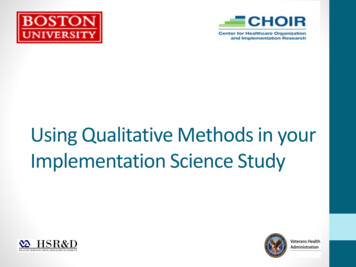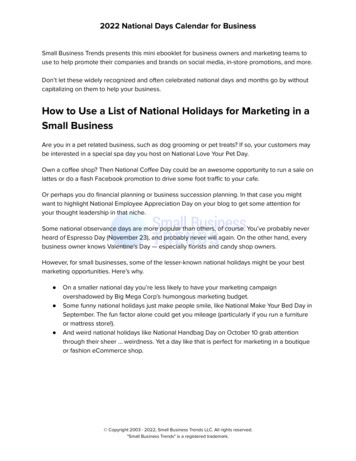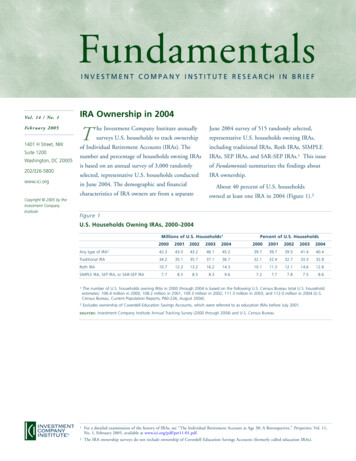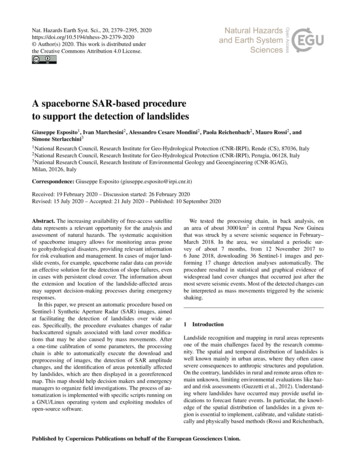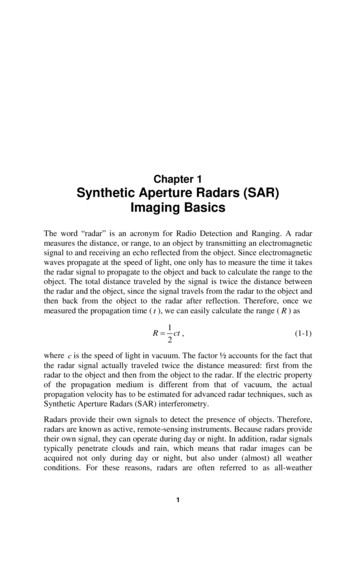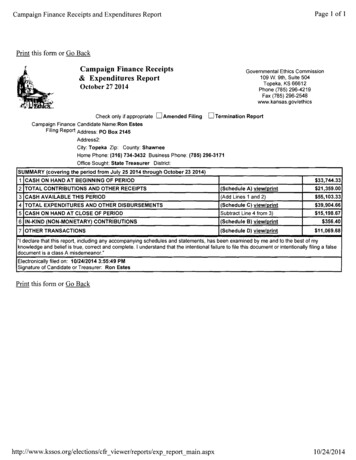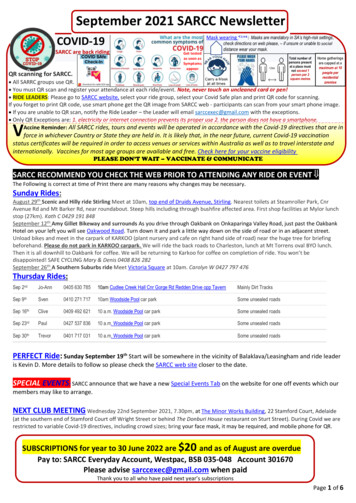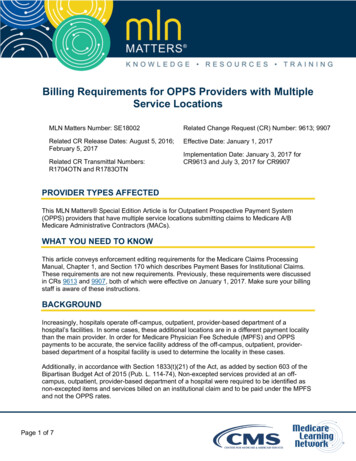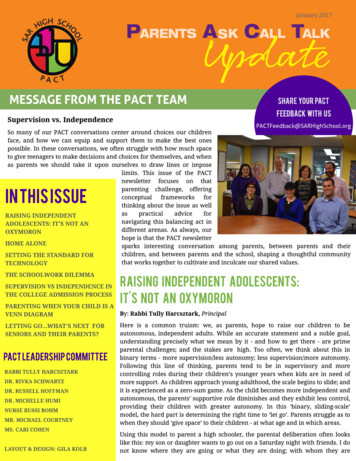
Transcription
January 2017MESSAGE FROM THE PACT TEAMShar e your PACTf eedback wit h usSu per v i si on vs. I n depen den cePACTFeedback@SARHighSchool.orgSo m any of our PACT conver sations center ar ound choices our childr enface, and how w e can equip and suppor t them to m ake the best onespossible. In these conver sations, w e often str uggle w ith how m uch spaceto give teenager s to m ake decisions and choices for them selves, and w henas par ents w e should take it upon our selves to dr aw lines or im poselim its. This issue of the PACTnew sletter focuses on thatpar enting challenge, offer ingconceptualfr am ew or ks forthinking about the issue as w ellaspr acticaladviceforRAI SI NG I NDEPENDENTnavigating this balancing act inADOLESCENTS: I T'S NOT ANdiffer ent ar enas. As alw ays, ourOXYM ORONhope is that the PACT new sletterHOM E ALONEspar ks inter esting conver sation am ong par ents, betw een par ents and theirchildr en, and betw een par ents and the school, shaping a thoughtful com m unitySETTI NG THE STANDARD FORthat w or ks together to cultivate and inculcate our shar ed values.TECHNOLOGYINTHISISSUETHE SCHOOLW ORK DI LEM M ASUPERVI SI ON VS I NDEPENDENCE I NTHE COLLEGE ADM I SSI ON PROCESSPARENTI NG W HEN YOUR CHI LD I S AVENN DI AGRAMLETTI NG GO.W HAT'S NEXT FORSENI ORS AND THEI R PARENTS?PACTLEADERSHIPCOMMITTEERABBI TULLY HARCSZTARKDR. RI VKA SCHWARTZDR. RUSSELL HOFFM ANDR. M I CHELLE HUM INURSE RUSSI BOHMM R. M I CHAEL COURTNEYM S. CARI COHENLAYOUT & DESI GN: GI LA KOLBRAISINGINDEPENDENT ADOLESCENTS:IT'S NOT AN OXYMORONBy: Rabbi Tu l l y Har cszt ar k , PrincipalHer e is a com m on tr uism : w e, as par ents, hope to r aise our childr en to beautonom ous, independent adults. W hile an accur ate statem ent and a noble goal,under standing pr ecisely w hat w e m ean by it - and how to get ther e - ar e pr im epar ental challenges; and the stakes ar e high. Too often, w e think about this inbinar y ter m s - m or e super vision/less autonomy; less super vision/m or e autonomy.Follow ing this line of thinking, par ents tend to be in super visor y and m or econtr olling r oles dur ing their childr en?s younger year s w hen kids ar e in need ofm or e suppor t. As childr en appr oach young adulthood, the scale begins to slide; andit is exper ienced as a zer o-sum gam e. As the child becom es m or e independent andautonom ous, the par ents?suppor tive r ole dim inishes and they exhibit less contr ol,pr oviding their childr en w ith gr eater autonomy. In this ?binar y, sliding-scale?m odel, the har d par t is deter m ining the r ight tim e to ?let go?. Par ents str uggle as tow hen they should ?give space?to their childr en - at w hat age and in w hich ar eas.Using this m odel to par ent a high schooler , the par ental deliber ation often lookslike this: my son or daughter w ants to go out on a Satur day night w ith fr iends. I donot know w her e they ar e going or w hat they ar e doing; w ith w hom they ar e
RAISINGINDEPENDENT ADOLESCENTS(continued from pg. 1)m eeting or if it w ill be safe. The ar gum ent fr om autonomy suggeststhat I tr ust my child. The anxious side of m e w ants to hover , to askquestions, to contr ol. And I pick a side.I pr opose shedding this binar y m odel in favor of a m or einter dependent m odel of the par ent-child r elationship, one w her eboth par ental pr esence and r espect for the independence of eachper son ar e constants - fr om childhood thr ough adulthood. In fact,that is how life w or ks. People ar e not tr uly autonom ous orindependent at all. M y fam ily, fr iends and colleagues have been soim por tant for my decision m aking, for the quality of my life andfor the w ays that I have gr ow n. Those r elationships pr op m e up,pr ovide m e w ith suppor t, br oaden my thinking, challenge m e. Intr uth, w e ar e all ?inter dependent?. Inter dependence suggest neithercontr ol nor autonomy. Inter dependence is r ooted in engagem entand r elationship - but acknow ledges that each per son in ther elationship is distinct, w ith his or her ow n m ind and per spective.We can tr anslate that into both educating and par enting. W hat dow e w ant for our kids? To over sim plify for a m om ent, w e w ant toteach and to pr ovide our childr en w ith thr ee things: 1) We w antour kids to have a cl ear sen se of val u es, of r ight and w r ong, of aw ay to live life. As Jew s, this cer tainly includes Tor ah and m itzvot,Shabbat, kashr ut, chesed and m uch else. 2) We w ant our kids todevelop a st r on g sen se of sel f ; w e m ight associate this w ith selfesteem , a sense of being ?good enough?, of being able to m akedecisions, of having a sense of agency - the ability to think, to act, tom ake change, to take r esponsibility. 3) We w ant our kids to knowthat w e bel i eve i n t h em . That does not m ean that w e do or w illagr ee w ith ever y decision that they m ake. It doesn?t even m eanthat w e fully tr ust them r ight now. It m eans that w e believe that ifthey lear n fr om those ar ound them , if they take life and itsr esponsibilities ser iously, ther e is so m uch that they can do - andw e believe that they can do it. And w e tell them so.We w ant all thr ee of these things for our childr en. But they ar e notthings that can be achieved thr ough r ules, super vision orim position alone. It r equir es a lifetim e of engagem ent,conver sation and connection - and a r eal r espect of each per son forthe thoughts, ideas and per spectives of the other.W hen achieved, r eal r elationship is per haps the deepest lifeexper ience. But deep connection is not achieved thr oughr elationships that ar e contr olling - nor is it best achieved by thesepar ation that com es w ith str iving for autonomy. It is builtthr ough consistent car e and conver sation that r espects thethoughts and feelings - and the dignity - of each par ty in ther elationship. And ideally, it should intensify as the year s go byr ather than dim inish.It is tr ue w ith spouses; it is so in fr iendship; and so it can bebetw een par ents and their young adults.2HOMEALONEBy: Dr . Ri vk a Sch w ar t z, Associate PrincipalAs a par ent, it?s gr eatly liber ating w hen our kids ar efinally old enough that w e can leave them hom e alonew ithout a babysitter. No m or e endless, fr uitless phonecalls to tr y to find a babysitter for a w edding on LaborDay Weekend; no m or e paying sur ge pr icingbabysitting r ates on New Year ?s Eve.That you can go out for an evening or an eventw ithout leaving an adult in char ge of your teenagechild is a no-br ainer. The question becom es m or ecom plicated w hen par ents ar e going aw ay for a m or eextended per iod of tim e. Can you leave your childhom e alone for Shabbat, or longer ? Should you?Let?s star t by stipulating that ther e w on?t be a sim pleone-size answ er to this question. A 14-year -old ninthgr ader , and an 18-year -old senior tw o m onths aw ayfr om living on her ow n, m ight elicit ver y differ entr esponses. (On the other hand, the fr eshm an is lesslikely to invite ten fr iends over for a sm allget-together , only to have it spir al out of contr ol.) Evenam ong students at the sam e age and stage of school,ther e w ill be vast differ ences of m atur ity and abilityto take r esponsibility for them selves. So this is notgoing to be a set of har d-and-fast r ules, but som ethings to keep in m ind w hen m aking this decision.Know your child (and be honest about this.) Ar e yousur e they?ll be okay, r esponsible, safe?If it?s over Shabbat, m ake sur e that Shabbat happensfor your child. Som e kids w ill get up, out to shul, andhave a Shabbat m eal on their ow n. Other s w ill stay inbed until 4 (Know your kid!) If your child is in thesecond categor y, you m ight w ant to ar r ange w iththem to stay w ith a fr iend for Shabbat, or get invitedto the neighbor s for a m eal.Have clear guidelines about inviting other s over w hile(continued on p. 7)
SETTINGTHE STANDARD FOR TECHNOLOGYBy: Rabbi Av i Bl oom , Director of TechnologyIn 2016, The Inter national Society for Technology in Education, ISTE, r eleased a new set of technology standar ds forstudents. The standar ds r eflect the cr itical r ole that technology plays in the lives of our students, and in the futur e forw hich w e ar e pr epar ing them . It also str ives to help m itigate the danger s and potential pitfalls that could develop w ithubiquitous technology use. The goal is to develop independent lear ner s, r esponsible digital citizens, innovative designer s,and global collabor ator s. At SAR, w e take these goals ser iously and w e str ive to par tner w ith par ents to help studentsachieve these benchm ar ks. We r ecognize that par ents play an im por tant r ole in cultivating an envir onm ent in w hich teensar e challenged to fully im m er se in the technology that sur r ounds them , in thoughtful, m eaningful w ays, w hile avoiding thepitfalls and challenges that ar e the ?danger s? of technology.To facilitate this par tner ship, w e encour age fam ilies to r ead and discuss the ISTE Standar ds (w hich can be found on theISTE w ebsite and in the links section at the end of this ar ticle). Par ents should fam iliar ize them selves w ith the ISTEstandar ds and use them as a spr ingboar d for fam ily conver sation. You can talk about the goals and r ationale of eachstandar d and think about w ays that you can help your childr en achieve these goals.Thr ee centr al them es in the ISTE standar ds ar e helping students develop as digital citizens, know ledge constr uctor s, andcr eative com m unicator s. Her e ar e som e guidelines, and gener al questions for par ents to use as you engage your fam ily inthis im por tant conver sation.?Digital Citizen? - In this standar d, ?Students r ecognize the r ights, r esponsibilities and oppor tunities of living, lear ning andw or king in an inter connected digital w or ld, and they act and m odel in w ays that ar e safe, legal and ethical.? Social M ediais an ar ea w her e par ents often str uggle to under stand the teen m indset. In her book ?It?s Com plicated?, Danah Boydar gues that w hile teens often seem to be natur ally com for table shar ing online, ther e is an im por tant r ole for par ents toplay in helping teens m ake r esponsible decisions. Use your ow n online shar ing as a m odel. Tell kids w hat you shar eonline and w hat you do not. Ask kids about w hat they feel com pelled to shar e, and w hat im pact they feel the shar ing w illhave. It?s also im por tant to talk to kids about safety online (not being a victim ), as w ell as r em inding them that our valuesof r especting the dignity of ever y per son m ust car r y over into the digital r ealm .?Know ledge Constr uctor ? - Her e, the goal is for students to lear n how to, ?Cr itically cur ate a var iety of r esour ces usingdigital tools to constr uct know ledge, pr oduce cr eative ar tifacts and m ake m eaningful lear ning exper iences for them selvesand other s.? Students often need guidance about how to m anage the infor m ation they find online. Her e, par ents can behelpful by discussing how you differ entiate betw een online sour ces. W hy do you choose the sour ces you choose? W hydon?t you tr ust the other s? W hilem any of us m ake these choicesintuitively, ar ticulating them to teenscan be ver y helpful.?Cr eative Com m unicator ? - ISTEdescr ibes this standar d as, ?Studentscom m unicate clear ly and expr essthem selves cr eatively for a var iety ofpur poses using the platfor m s, tools,styles, for m ats and digital m ediaappr opr iate to their goals.? W hilestudents m ay be m or e fam iliar w iththe ar r ay of choices fr om w hich theycan choose for their w or k, par ents,as exper ienced com m unicator s canm odel this pr actically. Show yourchildr en effective em ails you?vew r itten and pr esentations you?ve(continued on p. 4)3
THESCHOOLWORKDILEMMABy: Dr . Gai l Gu m or a, SLC CoordinatorPar ents pr otect their childr en - it?s built into the DNA of par enting. Theyper ceive a danger and take action. W hen childr en at any age ar e at r isk of notkeeping up w ith schoolw or k, par ents feel com pelled, even obligated, tointer vene. After all, the belief that academ ic success leads to lifelong success hasbecom e a m oder n day m antr a.Given the adolescent?s m ovem ent tow ar ds independence, par entalinter ventions take on unique char acter istics dur ing high school. Her e r est s t h edi l em m a - h ow m u ch does or can t h e par en t becom e i n vol ved?The answ er begins w ith the par ent becom ing m indful to pr oactively assess thesituation.----M onitor your fear : ?M y kid?s str uggle or failur e w ill only lead to fur ther failur es.? This kind of thinking w ill put youin a panic m ode, w hich your teenager w ill sniff out, cr eating som e hostility and a br eakdow n in com m unication.Engage in a m eaningful conver sation w ith your teenager , one that includes listening to his/her per spective. Listenw ithout judging--it w ill guide your r esponse and help both of you collabor ate on w hat action to take next.Collabor ation foster s r esponsibility.If your teenager denies that ther e is a pr oblem , under stand that the under lying m otive for avoidance is fear.Rem ar ks such as, ?I?m on top of it,? or ?Leave m e alone, I don?t car e,? ar e typical r esponses that suggest w or r y aboutdisappointing par ents.Offer to help w ithout becom ing intr usive. ?I?m happy to help, feel fr ee to ask .?Set aside tim e to w or k together. This w ill lim it the degr ee of str ess.W hen you suspect your teenager is ?playing helpless,? sensitize your self to the differ ence betw een enablingdependence and em pow er ing independence. A feeling of helplessness m ay be a function of anxiety r ather thanability.Finally, w hen a continuing patter n of m issed hom ew or ks, poor test scor es, or a gener al lack of inter est in schoolw or kper sists, seek the advice of pr ofessionals. Reaching out to exper ts helps both par ent and child find solutions thatneither m ay find on their ow n.SETTINGTHE STANDARD FOR TECHNOLOGY(continued from p. 3)given. Ask them how they feel about the w ay theycom m unicate and pr esent their ideas and explain yourstr ategies for effective digital com m unication.In gener al, w hen talking about technology, it?s im por tant toavoid using sw eeping gener alizations like ?Technology? or?Scr een Tim e? and be ver y specific and descr iptive.Technology is ever yw her e. It?s how w e r ead, w r ite, play,w atch, com m unicate, and lear n. Qualitative, descr iptiveconver sations w ill be m or e helpful than quantitativem easur em ents.As w e collabor ate to br ing these standar ds to your fam ilyconver sation, I w elcom e your feedback, questions andideas. I can be r eached at avi.bloom @sar highschool.or g.4For further reading:-The new ISTE standards for students http:/ / www.iste.org/ standards/ standards?It?s Complicated? by Danah Boyd http:/ / bit.ly/ boydcomplicatedThe PACT newsletter from March 2015 contains anumber of articles about the book - http:/ / bit.ly/ pact315Common Sense Media?s ?Parent Concerns? section(http:/ / bit.ly/ csmparenting) This is a free resource tohelp parents and families create meaningfulconversation and engagement around issues andquestions related to technology use.
SUPERVISION VS INDEPENDENCE IN THE COLLEGEADMISSION PROCESSBy: M r . M i ch ael Cou r t n ey, Director of College CounselingFor m any fam ilies, the college adm ission pr ocess is ananxiety-pr ovoking exer cise. The idea of taking students to visitcam puses, planning for the financial r ealities of a post-SAR education,and assisting childr en w ith num er ous college applications can bebur densom e for par ents. Som e students can use the hand-holding,w hile other s ar e m or e capable of independently m anaging the entir epr ocess. Her e ar e helpful pieces of advice for par ents in super visingtheir childr en thr ough the college application season w hile at thesam e tim e enabling them to be independent and tr uly pr epar ed forthe next step in their educational jour ney:--------Ensur e that not ever y dinner conver sation in the second halfof junior year and all of senior year r evolves ar ound the ?C?w or d. Allow your childr en to live in the pr esent and enjoytheir high school exper iences, r ecognizing that ther e is a tim eand place for college talk beyond supper. They m ight feel like you ar e constantly over seeing their adm issionpr ocess if you keep br inging up the w or d ?college? at the sacr osanct dinner table!Do not feed the fr enzy and feel the need to discuss your childr en?s adm ission pr ocess w ith your fr iends, nor feel theneed to ask your fr iends about their childr en?s application plans. Respect your childr en?s pr ivacy and your fam ily?spr ivacy. This also under scor es your plan for your sons/daughter s to feel like the pr ocess is ?their s? and they haveindependence in going thr ough the m ulti-step jour ney of high school to college.Ther e w ill be som e par ts of the pr ocess you w ant to let your child take char ge of, and som e w her e the par ent shouldtake contr ol. Par ents should be the ones filing the FAFSA (Fr ee Application for Feder al Student Aid) and CSS Pr ofile,attending financial aid pr esentations, and budgeting for the next four year s. Of cour se, you should have discussionsw ith your childr en about w hat your fam ily can/cannot r ealistically affor d, but the actual paper w or k r elated tofinancing should fall on par ents?shoulder s.Sim ilar ly, W hen it com es to college visits, par ents should ar r ange the initial tr ip. Then, if students w ant to r etur n forlonger stays at schools alr eady visited, they have the confidence that they can ar r ange for such an itiner ar y. Keep inm ind that the SAR College Counseling Team w ill take second sem ester junior s to visit tw o out-of-tow n cam puses andYeshiva Univer sity. W ith SAR, students have the oppor tunity to see Bingham ton/Cor nell, Br andeis/BostonUniver sity, or M ar yland/Johns Hopkins in one day.On the other hand, students should handle essay-w r iting on their ow n. (Colleges can tell w hen they?r e r eading thew or k of par ents or pr ivate consultants posing as teenager s.) Instead, encour age your childr en to sit for half an hour ,sans technological distr actions, and w r ite at their desk/dining r oom table. Of cour se, the SAR College CounselingTeam spends m any hour s w or king w ith each student on outlining and editing essays but the fir st steps to such anexer cise m ust be initiated by the senior.Do not ?expect? your childr en to attend a college that you w ish they?d attend based on your ow n per sonalpr efer ences or legacy standing. Of cour se, m atr iculating in an institution w ith a vibr ant obser vant Jew ish lifeshould be a non-negotiable but dem anding that they go to your alm a m ater or enr oll in a post-secondar y school thatfits a cer tain ?br and? can only under m ine their independence in the adm ission pr ocess.Encour age your sons/daughter s to stay or ganized, either thr ough physical folder s or online folder s in keeping tr ackof all item s r elated to the college application pr ocess. In r ecent year s, I have seen this or ganization thr ough Googledocs and students cr eating m ultiple folder s for cam pus visit notes, essay dr afts, and supplem entar y essays.Recognize that having m ultiple childr en w ill likely m ean having m ultiple adm ission exper iences. Know your sonsand daughter s--som e m ight be com pletely independent and need little super vision w hile their siblings m ight be(continued on p. 7)5
By: Dr . Ru ssel l Hof f m an , School PsychologistpARENTINGWHENYOUR CHILD IS AVENN DIAGRAMPar enting a teenager thr ough the tur bulent adolescent year s can bedistinctly challenging. Pr oviding guidance and setting lim its forteenager s can definitely push par ents past their ow n com for tablelim its. Even for par ents w ho have alr eady r aised one or m or eteenager s, adolescence can pr esent unique challenges for par ents thatr un the gam ut fr om am usingly difficult to infur iatinglyconfr ontational. Watching your child develop into a cr eative, abstr actthinker w ith talents and opinions of their ow n can be one of the m ostfulfilling aspects of par enthood. And yet, som e of the other tr aitsassociated w ith adolescence can stym ie even exper ienced, veter anpar ents. For instance, it is w ell-docum ented that teenager s ar e know nfor their tendency to challenge author ity, to oppose or defy lim its, andto m ake decisions that ar e based m or e on em otion and im m ediater esults r ather than r ational analysis of futur e consequences. Astr oublesom e as these tr aits ar e fr om a par enting per spective, it isim por tant to r ecognize that they ar e developmentally appropriate. Inother w or ds, these tr aits m ake sense w ithin the developm entalcontext of adolescence. And the developm ental context of adolescenceis, per haps, best illustr ated as a Venn diagr am .As the diagr am show s, the developm ental stage of adolescence isactually the tr ansition fr om childhood to adulthood. It begins w ith theonset of puber ty and ends w ith the com pletion of physical m atur ation(w hich culm inates w ith the finalization of br ain developm ent) and the individual?s full em er gence into adulthood. Dur ingthis tr ansitional tim e, teenager s have ?dual citizenship? in both the child and adult w or lds. Developm entally, adolescence ischar acter ized by qualities of both childhood and adulthood. This m eans that a teenager sim ultaneously - and par adoxically- has featur es of being both a child and an adult. This par adoxical dual natur e is w hat m akes par enting teenager s sodifficult and is often the r oot of teenager -par ent conflicts. For exam ple, teenager s ar e still childlike in that they lack lifeexper ience and the r esour ces to suppor t them selves, and they ar e not legally independent. On the other hand, they ar eadultlike in that they ar e becom ing incr easingly autonom ous and self-r eliant and they ar e incr easingly able to thinkr ationally and abstr actly about ever -m or e-sophisticated ideas. Consider how this Venn-diagr am m ed per son should bepar ented w hen it com es to deciding how they spend their tim e. Like an adult, they have a developm entally appr opr iatedesir e for m or e autonomy and self-deter m ination, but like a child, they r equir e som e guidance and super vision/over sightfr om adults in or der to pr otect their w elfar e (and teach them the decision-m aking skills they w ill need in the near futur e asfull-fledged adults). Ver y often, conflicts betw een adolescents and their par ents ar ise fr om a disagr eem ent about w hich sideof the diagr am is m or e salient in any given situation. W hen par ents focus on the child-like natur e of their teenager and setlim its or im pose consequences, that is often w hen the teenager feels that their par ents should accentuate their m or eadult-like qualities and allow them m or e independence. And w hen a teenager feels that their par ents should em phasizetheir m or e childlike natur e and pr ovide them w ith m or e assistance, that is often w hen par ents point out their teenager ?sadult-like qualities and their capacity for self-r eliance and autonomy.Keeping the Venn diagr am of adolescence in m ind can help par ents str ike the appr opr iate balance as they r aise theirteenager s. The diagr am can help r em ind par ents to individually assess the var ious situations that com e up in the cour se ofadolescent developm ent and to deter m ine w hich aspect of their teenager ?s par adoxical natur e is m ost r elevant for apar ticular situation. For instance, it can pr om pt par ents to ask them selves, ?in this situation, should I as the par ent setlim its and exer t som e contr ol over my still-a-child teenager , or should I allow my alm ost-an-adult adolescent the fr eedom todecide for them selves and to exer cise their ow n judgm ent? The diagr am can also help facilitate teenager -par entcom m unication because it can help par ents under stand and even em pathize w ith their teenager ?s m or e challengingattitudes and behavior s. Teenager s often chafe at the instr uctive and/or super visor y pr esence of their par ents, or challengetheir par ents?r ules or values. The diagr am can help par ents per ceive this fr ustr ating and pr ovocative behavior thr ough adevelopm ental lens, and to for m ulate their par ental r esponse in a w ay that acknow ledges and r espects both aspects of theirteenager s?dual natur e.6
HOMEALONE(continued from p. 2)you?r e aw ay. M aybe you encour age having fr iends over for Shabbat, to help cr eatea Shabbat feeling and exper ience. But know that a Satur day night gather ing for teninvited fr iends can, once posted to social m edia, easily, over w helm ingly becom e agather ing of dozens w hom your child doesn?t know.If it?s m or e than just over a w eekend, let the school know. We often see issues ar isew hen par ents ar e aw ay, fr om students com ing late to school because they?r e gettingyounger siblings out to anxiety about the r eason for a par ent?s absence.Rem em ber you?r e par enting a Venn Diagr am . (See Dr. Hoffm an?s ar ticle.)Teenager s w ant and need autonomy, but they also need super vision. If you have tobe aw ay r epeatedly, or for an extended per iod of tim e, it?s advisable to findsom eone for your child(r en) to stay w ith.W hile they w ould gener ally not be in play over a w eekend, child w elfar e issuesm ight be im plicated in leaving teenager s alone r epeatedly or for longer per iods of tim e. These law s var y by state.This discussion has been pr edicated on the assum ption that teenager s ar e in their usual envir onm ent, going to school andliving their usual lives w hile their par ents ar e aw ay. How ever , ther e?s another cir cum stance that, w hile super ficiallysim ilar , is substantively differ ent enough to m er it addr essing separ ately.Teenager s som etim es w ant to tr avel to vacation destinations in gr oups, w ithout par ental super vision. If the destination isFlor ida, they m ay nom inally be under the super vision of gr andpar ents; if the location is m or e exotic, they w ill likely be ontheir ow n. In either case, this is entir ely differ ent than having students in their ow n envir onm ent attending school w ithoutpar ents hom e for a few days. The challenges posed in these settings ar e differ ent in kind, and even w hen gr andpar ents ar epr esent, they ar e not necessar ily aw ar e of all the potential issues, or inclined or able to offer the sam e kind of hands-onsuper vision as par ents. For all of these r easons, w e caution against unsuper vised tr avel by high school students on thosesor ts of tr ips.Our teenager s?incr easing independence can be challenging in all sor ts of w ays--but w hen it com es to our being fr eed fr omcar pool duty and babysitter hunting, w e br eathe a sigh of r elief. As w e do, w e have to keep in m ind our childr en?s need forlim its and super vision along w ith their incr easing ability to handle autonomy and independence, and, w ith a clearunder standing of the individual child involved, to m ake thoughtful, infor m ed decisions, and par tner w ith the school toensur e the best outcom es for our childr en.super v ision vs independence in t he col l ege admission pr ocess(continued from p. 5)--com pletely dependent on you; you w ill still need to ensur e theirfeeling sem i-independent in this pr ocess. And w or k to keep yourener gy and enthusiasm up for your second (and subsequent) tim esthr ough the pr ocess. Childr en don?t w ant to get the sense thatpar ents have been thr ough the pr ocess m ultiple tim es and ar ejaded--for ever y child, it is his/her fir st tim e engaging in thepr ocess!Rem ind your childr en to stay on top of em ails and r ead thr ough theones that ar e im por tant. And m ake sur e they set up a ?gr ow n-up?em ail addr ess if they don?t have one alr eady, such asfir stnam e.lastnam e@gm ail.com .Par ents should think of them selves as cheer leader s in the collegeadm ission pr ocess. The students ar e the player s, w r iting thecontent and clicking ?subm it?, but the par ents ar e the ones offer ingunconditional suppor t and love.7
l et t ing go.what 's next f or senior s and t heir par ent s?By: Car i Coh en , Assistant Director of College CounselingSo, your son or daughter is in their final year of high school,slow ly beginning to r ealize that life at SAR is com ing to an end.Your em er ging young adult m ay be feeling a m ix of em otions:excitem ent, sadness, fear of the unknow n, or anxiety about theupcom ing changes. How can you suppor t your child,r ecognizing that their judgem ent and decision m aking skillsar e still developing? And how can par ents help students w hilethey too ar e coping w ith m onum ental changes in the fam ily,feeling pr ide and sadness, and ever ything in betw een?It?s im por tant to r ecognize that m any fam ilies w ill feel as ifthey?r e on an em otional r oller coaster. Talking to other s w hoar e either in the sam e situation as you ar e, or have been ther ebefor e, can help to em pathize w ith the w ide r ange of positive and negative em otions that you m ight be feeling. Thesetr ansitional tim es affect both par ents and students.As par ents, w e w aver betw een encour aging our teenager s to becom e independent beings yet encour aging them to m akethoughtful, consider ed plans. W hile they ar e budding individuals, they still need adult guidance, som eone to considerscenar ios that they m ight not anticipate. As fam ilies pr epar e to send their childr en off to college, it?s cr ucial to stayconnected. Let your child initiate the conver sation w hen they have tim e, allow ing them to com m unicate w ith you on theirow n ter m s and in their ow n t
is an area where parents often struggle to understand the teen mindset. In her book ?It?s Complicated?, Danah Boyd argues that while teens often seem to be naturally comfortable sharing online, there is an important role for parents to play in helping teens make responsible decisions. Use your own online sharing as a model. Tell kids what you share
